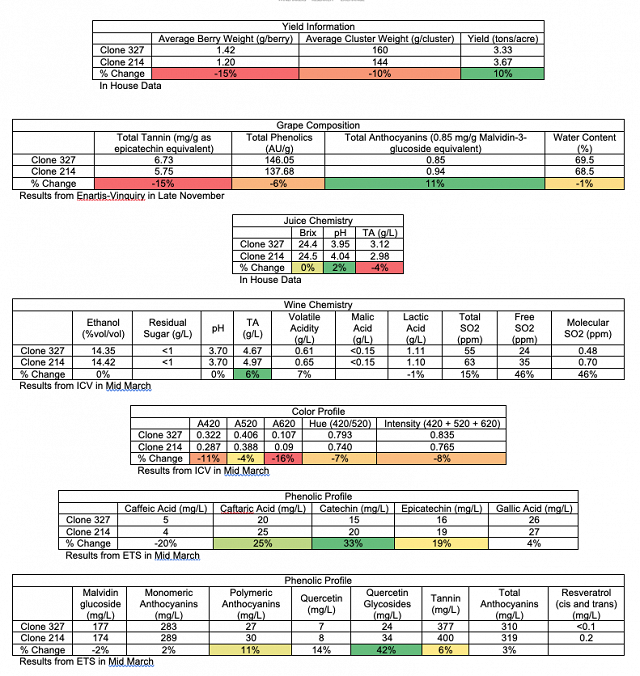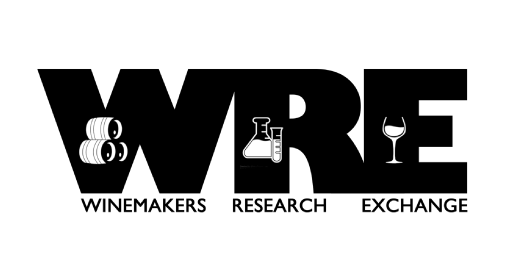Clonal Assessment of Cabernet Franc (2017)
Submitted by Matthieu Finot
King Family Vineyards
Summary
This study examines the clonal differences between Cabernet Franc clones 214 and 327. Grapes were harvested separately on October 4, 2017. Must was inoculated with ES488 and was pressed off after around 18-19 days of maceration. Both wines received the same additions, and all other treatments were identical between wines. Clone 327 tended to have higher berry weight and cluster weight, although yield was slightly lower. Grape chemistry suggests that clone 214 had lower tannin and phenolics, but slightly higher anthocyanins. Juice and wine chemistry did not differ too much. Clone 214 wine tended to have slightly higher phenolic parameters, although these differences were weak. It is possible, then, that although Clone 214 had lower levels of phenolic compounds (except anthocyanin), phenolic compounds were more extractable from these grapes. However, Clone 214 received an addition of Lafase HE Grand Cru which Clone 327 may not have received, and this may have impacted the results as well. Overall, the wines were not found to be significantly different via triangle testing. Descriptive analysis did not yield any consistent trends between tastings. There may have been a slight preference for Clone 327, but this was weak. More work should focus on the sensory and chemical differences between wines produced from these clones, but more work should also be done to better distinguish viticultural characteristics between these wines, as well.
Results and Discussion
Clone 327 tended to have higher berry weight and cluster weight, although yield was slightly lower. Grape chemistry suggests that clone 214 had lower tannin and phenolics, but slightly higher anthocyanins. Juice and wine chemistry did not differ too much. Clone 214 wine tended to have slightly higher phenolic parameters, although these differences were weak. It is possible, then, that although Clone 214 had lower levels of phenolic compounds (except anthocyanin), phenolic compounds were more extractable from these grapes. However, Clone 214 received an addition of Lafase HE Grand Cru which Clone 327 may not have received, and this may have impacted the results as well.

For the triangle test on April 18, of 10 people who answered, 4 people chose the correct wine (40%), suggesting that the wines were not significantly different. There were no distinguishable preference trends between each treatment. There were no strong trends for the descriptors used in this study. There were not many small trends as well, except that Clone 214 may have had slightly higher Overall Aromatic Intensity.
For the triangle test on May 2, of 22 people who answered, 9 people chose the correct wine (41%), suggesting that the wines were not significantly different. In general, of people who answered correctly 6 preferred Clone 327, and 3 preferred Clone 214. For the descriptive analysis, there were no strong trends for the descriptors used in this study. There was a slight tendency for Clone 327 to have higher Fruit Intensity, and for Clone 214 to have higher Astringency.
Overall, the wines were not found to be significantly different via triangle testing. Descriptive analysis did not yield any consistent trends between tastings. There may have been a slight preference for Clone 327, but this was weak. More work should focus on the sensory and chemical differences between wines produced from these clones, but more work should also be done to better distinguish viticultural characteristics between these wines, as well.
Methods
Two clones of Cabernet Franc (clones 327 and 214) from similar vineyard blocks and grown using similar viiticultural techniques were harvested separately on October 4, 2017. The grapes were refrigerated overnight and processed the following day into separate T Bins. Each must received 25-30ppm sulfur dioxide. After processing, must was inoculated with 15g/hL ES488. The next day, 0.05g/L Lafase HE Grand Cru was added to clone 214. It is unclear whether clone 327 received this addition. Clone 214 received 0.3g/L Malic acid and 1.5g/L Tartaric acid at crush, and clone 327 received these additions the day after. Both wines received an additional 0.2g/L Malic acid and 1g/L Tartaric acid on October 18. Wines were pressed off on October 23 (around 18-19 days of maceration) into tank, settled overnight, and then racked to identical barrels. Both wines received 1g/L tartaric acid on November 23. Clone 214 received 0.33g/L tartaric acid on January 5, but it is unclear if clone 327 also received this addition. Both wines were stabilized with 66ppm sulfur dioxide after completion of malolactic conversion.
These wines were tasted on April 4 and April 18. For the triangle test, descriptive analysis, and preference analysis for the April 4 tasting, anybody who did not answer the form were removed from consideration for both triangle, degree of difference, and preference. Additionally, anybody who answered the triangle test incorrectly were removed from consideration for degree of difference and preference. Additionally, any data points for preference which did not make sense (such as a person ranking a wine and its replicate at most and least preferred, when they correctly guessed the odd wine) were removed.
In order to balance the data set to perform statistical analysis for descriptive analysis on the April 18 tasting, any judge who had not fully completed the descriptive analysis ratings were removed. In order to then make the number of judges between groups equivalent, one judge from group 3 was eliminated. This resulted in a final data set of 3 groups, each with 3 judges (considered as replications within groups, and groups were considered as assessors). Data was analyzed using Panel Check V1.4.2. Because this is not a truly statistical set-up, any results which are found to be statistically significant (p<0.05) will be denoted as a “strong trend” or a “strong tendency,” as opposed to general trends or tendencies. The statistical significance here will ignore any other significant effects or interactions which may confound the results (such as a statistically significant interaction of Judge x Wine confounding a significant result from Wine alone). The descriptors used in this study were Fruit Intensity, Herbaceous/Green, Overall Aromatic Intensity, Avidity, Astringency, and Body.
The same procedures for data analysis were used on the May 2 tasting. For the descriptive analysis in this tasting, one judge was eliminated from group two so that each group had 8 judges, for a total of 24 judges.
